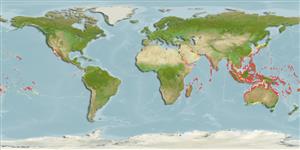Common names from other countries
Environment: milieu / climate zone / depth range / distribution range
Écologie
; profondeur 0 - 30 m (Ref. 96667). Tropical
Indo-Pacific: French Polynesia to Japan, Australia and the Indo-Malayan region.
Length at first maturity / Taille / Poids / Âge
Maturity: Lm ? range ? - ? cm Max length : 10.5 cm TL mâle / non sexé; (Ref. 3148)
Description synthétique
Morphologie
Sexual dimorphism, males have dark greenish coloration while females are whitish green.
Inhabits shallow water especially in upper intertidal zone (Ref. 3510, 80410) in reef flats and tidal flats under rocks and boulders or inside coral or rock crevices (Ref. 87055). Subtidal (Ref. 106854). It actively moves in between coral heads for prey (Ref. 80410).
Life cycle and mating behavior
Maturité | Reproduction | Frai | Œufs | Fécondité | Larves
Some members of the order Stomatopoda pair for life and some come together only to mate. Males produce sperm ducts rather than spermatophores; females can brood a maximum of 50,000 eggs. Life cycle: Eggs hatch to a planktonic zoea which lasts for 3 months.
Ahyong, S.T. 2001. (Ref. 3099)
Statut dans la liste rouge de l'IUCN (Ref. 130435)
statut CITES (Ref. 108899)
Not Evaluated
Not Evaluated
Menace pour l'homme
Harmless
Utilisations par l'homme
| FishSource |
Outils
Sources Internet
Estimates based on models
Preferred temperature
(Ref.
115969): 24.4 - 29.3, mean 28.3 (based on 3706 cells).
Vulnérabilité
Low vulnerability (10 of 100).
